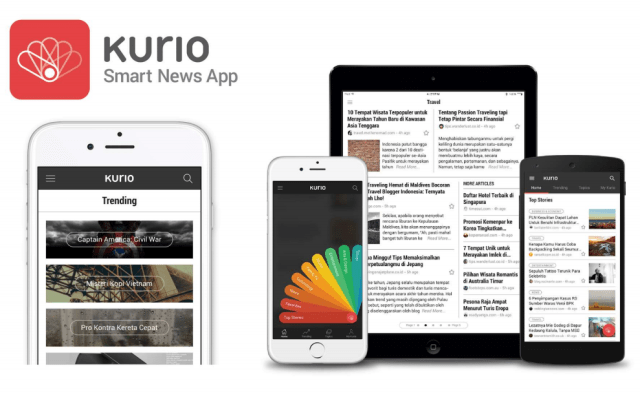In a case of one news-reader app helping another, Japan’s Gunosy has invested $5 million in Indonesia-based Kurio.
Gunosy went public in Tokyo last year; this year it has embarked on a series of investments, which included the acquisition of game strategy site Game8. Now it is turning to Southeast Asia by stumping up the cash for Kurio’s Series B round, which values the Indonesian startup at around $12 million, according to a filing [PDF in Japanese].
Contrary to the assumption that Gunosy’s investment is the precursor to an acquisition, David Wayne Ika — co-founder and CEO of Kurio — told TechCrunch that his company is plotting for a public listing just like Gunosy. Kurio already has links with Japan, having taken past investment from CyberAgent Ventures, and Ika said that a funding-led trip to Japan yielded nine prospective investors from the country.
Ultimately, Kurio chose Gunosy, he explained, because of the experience that it can lean on from its Japanese partner.
“Given [the current state of investment in] the Indonesian market right now, we need smart money,” Ika told us in an interview.
Gunosy has already eked out profitability in the face of competition from Smartnews, a Japanese company that has raised big and expanded to the U.S., and Flipboard, which made Japan one of its first international priorities. That, Ika added, is one example proving that it is the right advisor to help Kurio fulfill its ambition to scale across Southeast Asia and begin making money from its service.
Right now, Kurio has more than 200 media partners in Indonesia, where it claims 600,000 downloads, 90 percent of which are on Android. The company has begun to contact potential partners in Singapore and Malaysia, and it has ambitions to be in all parts of Southeast Asia with Romanic alphabet languages right now — the rest will require additional resources, Ika said.
Publishers once viewed news-reader companies as entities that compete for its users, and use its content in the process. That view has shifted among forward-thinking media firms, who appreciate that the best news readers bring a ready-made audience for new exposure and potential advertising money. Ika said that this perspective — that news-reader companies can help in this challenging era of social media — is growing worldwide, but still many media in Southeast Asia are behind the curve.
That’s particularly ironic because, in countries like Indonesia, smartphones and tablets are the overwhelming platforms for accessing the Internet and consuming media. As few have a dedicated mobile strategy, partnerships with specialists like Kurio could be one way to adapt to mobile.
Ika said publishers used to treat Kurio “like a threat,” but now many are beginning to see the benefits.
“The biggest problem we want to address for publishers is that 60-65 percent of their viewers come from mobile but, right now, their revenue is probably only 15-20 percent from mobile,” he said. “We’re working closely to figure out how to offer good advertising and marketing without disrupting the user experience.”
Kurio, Ika said, will begin testing advertising — both in-app and in-article — with selected partners before the end of the year. Beyond just offering new opportunities to attract an audience (and, in time, to make money), he said the service also gives publishers a chance to better understand their readers and tweak their approach accordingly. It is working on a dashboard that will equip media partners with “rich data across million of users,” including its own “interest and preference graph” that can be used for editorial or advertising purposes.
